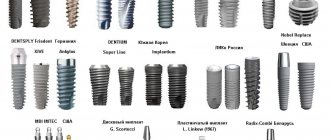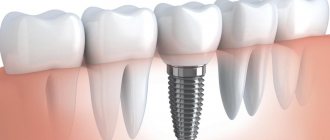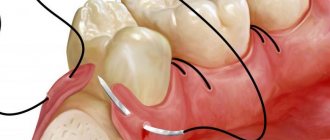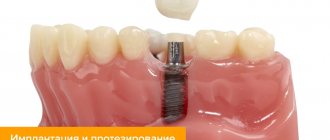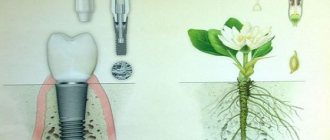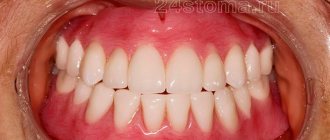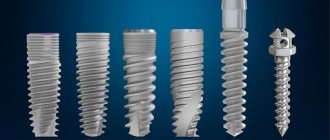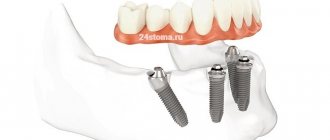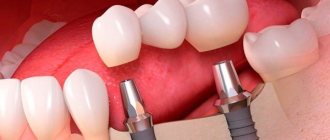The innovative ROOTT implant system is the optimal solution for any patient who is indicated for dental implantation. The system includes a set of solutions developed based on years of experience of Open Dental Community (ODC) implantologists and scientists, as well as practical research on the results of proven dental implant protocols. All implants are made from high-quality biocompatible titanium alloy.
Over the years, information has been collected to create a unified system of clinical cases, which identifies the main problems of each standardized case and options for solving them. Thus, based on collective experience, it was possible to create a unified system of optimal solutions for clinical cases (that is, which designs, installation methods, features of implant coating and which orthopedic design will be most effective for each specific situation). The ROOTT dental implant system was developed with the goal of combining all implantation options in one line of implants, so that each doctor has the opportunity to select the most effective individual treatment for the patient within one system.
History of creation
The roott method originated in France. Its discoverer was Gerard Scortecci. As an implant dentist, he conducted an experiment in which he involved not only the spongy layer, but also the cortical layer. The experiment was a success.
At that time, for root implantation, special structures were used, which were made by implantologists in Switzerland. They were made using special latest technology. The result was dental implants that had different designs, shapes, types and sizes. In addition, they differed from each other in coating. Thanks to this diversity, Roott implants could be used in a wide variety of clinical situations.
Root implantation came to our country only in 2011. The times of the Soviet Union served very poorly for root implants. Back then, almost all the latest technologies were beyond our reach. Only during Russian times were our people able to take advantage of these technologies. Many have suffered greatly from this inaccessibility. This is because people were unable to efficiently and effectively restore their teeth from a young age. As a result, they now experience complete destruction of the remaining teeth and bone tissue atrophy.
Roott quickly gained popularity. They moved forward thanks to the fact that until that time there were only implants on the dental market that were installed according to a two-stage protocol. This was a classic in dentistry. Roott opened the door for doctors to see better and more effective treatments. Doctors saw that it is now possible to restore lost teeth without resorting to bridges and removable prosthetics. This was a real breakthrough that made it possible to treat patients with bone deficiency. Moreover, the duration of treatment and the minimalism of injuries have always suited the patients.
Technology development
It is worth mentioning the process of implant evolution itself. Developers together with doctors have always tried to improve implants. But their work was almost always slowed down by the commercial interests of manufacturers. The process of evolution was also influenced by the lack of capabilities of dental clinics, which manifested themselves in the lack or complete absence of the necessary equipment. Dentists offered their patients only standard solutions to the situation, resorting to long-known and proven implants. It was convenient for doctors to use what was proven, rather than waste time delving into new technologies. Almost all patients received the same implants, regardless of the specific situation. Some implant designs did not live up to expectations. These include, for example, disk and plate structures. Despite the fact that they are able to integrate into very thin bone, the rate of injury during their installation is quite high. Therefore, the likelihood of successful treatment is very low.
In contrast to such designs, the roott had and still has threads and coatings that fully meet international standards. The material of Roott implants is completely biocompatible with the human body. The developed concept of these implants makes it possible to solve and cure very complex and time-consuming dental problems.
Root Features
Root refers to basal one-stage implantation, which is fundamentally different from the screw implantation previously used in dentistry. It has always been used to restore teeth. But there were cases when the patient did not have enough bone tissue and it was impossible to immediately use the screw method. In these cases, dentists had to build it up in a long and laborious manner. With basal roott implantation this procedure can be avoided.
The essence of such implantation is the implantation of a structure that is selected individually. This method is especially suitable for people with strong periodontal disease, the absence of many teeth, and for patients suffering from tissue atrophy.
Let us list the distinctive features of the root implantation procedure:
- Minimum treatment period: no more than 5-7 days. Many patients are pleased with the appearance of new teeth within a week.
- The percentage of injury during implantation is minimal.
- Average level of aesthetics. A higher level is obtained after re-prosthetics.
- Installed root implants can last a lifetime.
- These implants are excellent for chewing food.
- High product stability.
- The function of normal chewing of food returns on the 4th day after the operation.
- High maneuverability of the procedure provides enormous opportunities during treatment.
- There is no need to build up bone tissue, even if it is clearly deficient.
- Bone atrophy stops, since the load during chewing is distributed evenly and the cells are provided with adequate nutrition.
- The implant material is pure titanium, which is biocompatible.
- There is no need, even with very severe atrophy, to increase the size of the bone.
- The procedure for installing root implants does not cause severe discomfort or unbearable pain.
- The recovery process after treatment is pleasing with its short duration.
- Root implants have all the necessary quality certificates.
However, the roott implantation procedure requires the patient to be healthy. The patient should not have any infections. Otherwise, the implant may be rejected.
Benefits of root
Considering the procedure from several angles, the following qualities of root implantation are distinguished: efficiency, speed, reliability and painlessness.
On the speed side, the following stand out:
- There is no need to wait 12 months for complete engraftment of the installed material.
- After tooth extraction, implants can be installed immediately.
- Due to the fact that the implant and root abutment are a one-piece structure, fixed prostheses can be installed on the third day after implantation.
From the side of painlessness:
- In case of missing all teeth or a very large number, root implants are installed in one visit to the doctor.
- The installation method is minimally invasive, it does not injure the gums and remains absolutely sterile. As a result, the rehabilitation period is reduced significantly.
- The special shape, coating, thread and installation method make the healing process several times faster.
On the efficiency side:
- Visual aesthetics and the necessary chewing function are returned to the patient very quickly.
- The implant takes root during the operation of the installed tooth.
- Incisions and suturing are excluded in this process. The patient experiences virtually no discomfort or unwanted pain.
- This treatment method is ideal for those who do not want or do not tolerate the actions of surgeons.
The reliability of implant installation is characterized by the following points:
- Rejection of implants is excluded, since they are made of modern, well-compatible and many times tested materials.
- Ruth implants are capable of working with absolutely all bone sections.
- Implants are selected individually for each case and patient. This ensures a 100% positive result.
- You can “work” with your teeth almost immediately after installation.
Implantology training
Do you consider training important in your dental career? Would you like to learn more about the possibilities of restorations based on ROOTT implants? We always have up-to-date information on training courses organized by key leaders in the community dental community (ODC). This is a chance to gain expert knowledge in the field of implantology. Learn from excellent surgeons through intensive training. Take your surgical skills to the next level to manage complex implant cases.
Installation procedure
To install the described implants, you must go through the following steps:
- The first stage: selecting the right solution. At this stage, the dentist selects a protocol for solving the problem and the necessary implant for this case. During the examination, indications and contraindications are assessed, and studies are carried out that provide information about the thickness and density of bone tissue. A tomography of the jaw is possible.
- Second stage: direct installation. And depending on the case, the implant can be installed in the tooth socket itself using the gum peeling method and the puncture method.
- Third stage: prosthetics. After installing the implant, the doctor places the patient with a fixed prosthesis made of metal-plastic or temporary crowns.
- Stage four: fitting of a permanent prosthesis. Here the fitting and grinding of the prosthesis takes place.
- Fifth stage: attachment to the implant. Fixation occurs with cement.
Types of root
Modern and very successful implants are divided into 3 types:
Roott form
These are classic two-part implants that are installed into the root, and specifically into the spongy layer of bone. These implants require an incision in the gum. However, there are individual cases when the device can be placed through a puncture or in one stage with tooth extraction. Rootform is almost always used in aesthetic areas or when there is only one defect.
These implants are indicated for patients who are missing one or more teeth (the teeth must be missing in a row) or are completely edentulous. The entire treatment process with such devices lasts 3-9 months depending on the case.
Roott compressive
Refers to compression implantation. The abutment and implant here are a single whole, so they can be installed in one stage with the removal of the diseased tooth. While working with these implants, dentures are installed after a short time (a few days will be enough).
Compared to the previous type, Root compressive is installed in deeper layers of bone. These layers include the basal and cortical. These layers are good because the process of atrophy practically does not occur in them. Thanks to this, the implant can be securely fixed. These implants are most often used for complete or partial edentia.
Roott basal
These basal implants are widely used for atrophy of the uppermost bone layers. In addition, this type of implants is used on the upper and lower jaw. And the last indication for installing root basal implants is the absence of a large number of teeth. There is also no need to build up bone tissue. The Roott basal installation method is transgingival.
Manufacturer information
The headquarters of the company, which owns the ROOTT brand (“Root” or “Rutt”), is located in Zurich, Switzerland. The production of Ruth system implants is located in the European Union, and the products are supplied to several European countries, India and Argentina. Despite the relative youth of the brand - it has been represented in our country since 2013, the company notes that it has established connections with suppliers of high-quality raw materials. It also uses modern equipment in the production of ROOTT implants, thanks to which they comply with international quality standards. In addition to implants, gum formers, abutments, and surgical kits are produced under the Ruth brand. Actually, everything you need for implantation.
Price
What is especially pleasing about root implantation is the fixed cost of treatment, which includes the preparation of impressions, the work of the dentist, the manufacture of a prosthesis, correction of the prosthesis, tooth extraction (if necessary) and diagnostics. The cost of the entire jaw will be several times cheaper than installing implants using the classical method.
A definite plus: roott saves money and time. What is especially pleasing about this is that the quality of work and the result do not suffer from this.
Types of implants
The first implant was a T-shaped collapsible structure, which consisted of a rod and a disk. They did not last long, because... have proven to be ineffective. In the early 2000s, new designs emerged to replace T-shaped implants that required surgical, physiological, or psychological stress. The latest generation of implants, which includes the ROOTT implantation system, are recognized as the most effective today.
Implants are made of titanium alloys. The abutment is made from zirconium or titanium.
Contraindications
Despite a very impressive list of advantages, root implantation cannot be resorted to:
- If there is a pregnant or breastfeeding woman in the dentist's chair.
- The alveolar ridge is no more than 0.5 cm wide.
- Serious ailments in the oral cavity: tartar, pulpitis, acute form of stomatitis, cyst, granuloma.
In exceptional cases, it is possible to restore teeth with roott implants in case of AIDS, cardiovascular diseases and if the patient smokes. In the case of a patient with bruxism, implantation with the described structures is also possible, but only if the patient wears mouth guards at night.
Root implantation does not contain any restrictions regarding the patient's age. But the recommended minimum age is 19 years. It is at this age that it is most effective to restore teeth, since jaw growth has already stopped.
Alternative Methods
Removable prosthetics Recommended if there are absolute contraindications to implantation or if there is a limited budget
Clasp dentures A plastic frame on a durable metal arch, simulating gum, with tooth crowns inserted into it
Bridges Crowns rest on your own teeth on both sides. Suitable for restoring one or more teeth in a row
Article Expert
Voznyuk Vladimir Aleksandrovich Implant surgeon, doctor of the highest category
Work experience: more than 35 years
Reviews
I wasn't in a very bad accident, but I managed to lose my teeth. I was so upset that they were visible. My friend scared me by saying that it would take a very long time to build up the bone and the time of an ugly and unaesthetic smile would drag on for six long months. The verdict was harsh. But I came to the dentist, where an understanding doctor suggested I get one-stage RUT implants. I was told about the many benefits of this basal implantation. You know, they convinced me. The operation was painless and quite quick. This made me especially happy. I got used to the new teeth almost immediately. They seemed stunningly beautiful to me. My teeth look very natural. So now I don’t remember the accident.
I consider root implants a real breakthrough in the field of dentistry. They not only satisfied all my desires for a painless process and cheap installation, but in the end I received high-quality and reliable teeth. No wonder the dentist at the clinic described these implants to me like that. They are wonderful. After the operation, the rehabilitation period did not cause me any unwanted troubles. Thanks to the developers. Now teeth can be restored quickly, effectively and inexpensively.
I have already resorted to dental implantation, but my teeth were restored with completely different designs. And my last tooth was done with roott implants. The difference is noticeable. Firstly, the price. It was not possible for me to find big money for teeth. Besides, this was not my first tooth done. And roott were quite affordable and acceptable for me. Secondly, it is the speed of the procedure and the entire complex treatment. I say, as always, in comparison with other implants. I spent little time at the dentist during the implantation procedure and did not recover from the operation for long. In addition, the recovery period was quite easy. Thirdly, the procedure itself caused little trauma to the oral cavity. This cannot be said about third-party implants. Fourthly, I am very pleased that the manufacturer provides a guarantee. In addition, doctors claim that implants will be worn for life.
Sources used:
- “Implant-supported prosthetics” (Wohlfart S.)
- Unclassified materials. Illustrated manual on dental implantology (photo album): monograph. / A.I. Zhusev. - M.: Natalis, 2012.
- "Dental Implantology: Surgical Aspects" (Michael S. Block)
Comparison with implants from other brands
If we consider the global market for implantation products and modern protocols for restoring teeth on implants, we cannot fail to note the Oneway Biomed brand from Ihde Dental AG (founded in the mid-twentieth century in Switzerland) and its Strategic Implant concept. About 40 years ago, this company, after long and hard work, created basal and compression implants in the form in which they are produced by other manufacturers under similar names. In fact, ROOTT implants are a copy or analogue of Oneway Biomed models. Only younger and less explored, as well as exclusive.
Interesting to know! By comparison, Oneway Biomed products are supplied to almost 50 countries, and more than 1 million implants are produced every year. The brand is represented very widely around the world and in our country. That is, the patient has a real opportunity to place such implants near his home, and then undergo examinations in comfort.
Reviews from dentists about ROOTT implants can be called realistic only after these systems “cross” the mark of 20-30 years of operation in a large number of patients. Moreover, the operation will be accompanied by regular and massive research - survival rates for 10-15 years, the number of peri-implantitis, rejections, etc. By the way, the leaders of the global implantation market - the Swiss Nobel Biocare and Straumann (known for more than 40 years), constantly conduct similar studies and openly publish their results. Just like the company Ihde Dental AG, which about 30 years ago developed basal implantation in its modern version.
